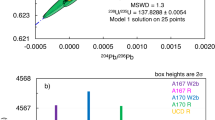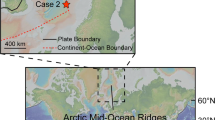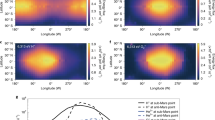Abstract
GENTRY1 has reported that some anomalous haloes found in ancient mica seem to arise from the α-decay of polonium isotopes only, without any observable long-lived β-emitting precursors. Fremlin2 suggested that these might occur as a result of the diffusion of β-emitting radiogenic lead isotopes from relatively distant or widely dispersed uranium or thorium inclusions, and the absorption of the lead ions by small preexisting inclusions of foreign material. As Gentry3 pointed out, this would involve abnormally high diffusion rates for lead. We have carried out experiments that demonstrate the possibility of such high rates. Here we also discuss the reasons for the absence of an excess of observable tracks left in mica by the recoil of the lead daughter when α-decay takes place in the polonium isotopes.
This is a preview of subscription content, access via your institution
Access options
Subscribe to this journal
Receive 51 print issues and online access
$199.00 per year
only $3.90 per issue
Buy this article
- Purchase on Springer Link
- Instant access to full article PDF
Prices may be subject to local taxes which are calculated during checkout
Similar content being viewed by others
References
Gentry, R. V. A. Rev. Nucl. sci. 23, 347 (1973); Nature 244, 282 (1973); 252, 564 (1974).
Fremlin, J. H. Nature 258, 269 (1975).
Gentry, R. V. Nature 258, 269 (1975).
Crozaz, G., Hair, M., Maurette, M. & Walker, R. M. Proc. Int.Conf. Nucl. Track Registration in Insulating SolidsClermont-Ferrand, Sect VII, 41 (1969).
Fleischer, R. L., Price, P. B. & Walker, R. M. Nuclear Tracks in Solids, 210 (University of California Press, Berkeley 1975).
Nagpaul, K. K., Mentor, D. D. & Gupta, M. L. Pure appl. Geophys. 112, 140 (1974).
Author information
Authors and Affiliations
Rights and permissions
About this article
Cite this article
HASHEMI-NEZHAD, S., FREMLIN, J. & DURRANI, S. Polonium haloes in mica. Nature 278, 333–335 (1979). https://doi.org/10.1038/278333a0
Received:
Accepted:
Published:
Issue Date:
DOI: https://doi.org/10.1038/278333a0
This article is cited by
-
Heating and radiation effects on optical and m�ssbauer spectra of Fe-bearing cordierites
Physics and Chemistry of Minerals (1984)
Comments
By submitting a comment you agree to abide by our Terms and Community Guidelines. If you find something abusive or that does not comply with our terms or guidelines please flag it as inappropriate.



